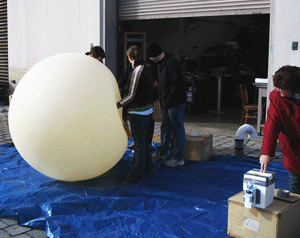 University
Park, PA — Plumes of ozone-producing pollution routinely cross political
boundaries, influence local regulatory efforts and impact health and the
environment, according to a team of atmospheric chemists trying to trace
ozone in the lower atmosphere.
University
Park, PA — Plumes of ozone-producing pollution routinely cross political
boundaries, influence local regulatory efforts and impact health and the
environment, according to a team of atmospheric chemists trying to trace
ozone in the lower atmosphere.
"There is a connection between pollution in Mexico City and in Houston, Texas," said Anne M. Thompson, professor of meteorology, Penn State. "The spring, which is the end of the dry season, is the beginning of field burning. That is when the winds move toward the U.S. so that Houston gets an added boost of ozone into their cycle."
Thompson and a large team of researchers carries out a program launching ozonesondes in experiments that measure ozone and other variables in the atmosphere. The ozonesonde instrument packages are carried into the air by weather balloons. Recently, Thompson's team tested the air in the Mexico City area and Houston, and in Richland, Wash. Pollution in Mexico City affects U.S. Gulf Coast areas including Houston. Richland is affected by pollution coming across the Pacific Ocean from Asia.
The airborne instruments measure temperature, relative humidity, elevation, location -- if a geographic positioning system instrument is aboard -- and ozone. The balloons reach an altitude of between 22 and 25 miles before they explode due to decreased pressure and the instrument package falls to Earth and shatters.
Ozone is manufactured in the atmosphere by sunlight working on a combination of hydrocarbons, carbon monoxide and nitrogen oxides, all chemicals created by burning organic fuels. Ozone can be either a good chemical or a pollutant, depending on where it occurs in the atmosphere. In the upper atmosphere, ozone provides a shield against the sun’s ultra violet radiation, but in the lower atmosphere, it is a pollutant that causes health problems and can damage crops.
"In August, over Mexico City, we recorded a level of 150 parts per billion of ozone," Thompson told attendees at the fall meeting of the American Geophysical Union in San Francisco, today (Dec. 11). "In the U.S., the standard is 80 parts per billion averaged over eight hours."
With the Mexican/Houston experiment, the researchers did find a link between ozone levels in the Mexico City area and levels a few days later in Houston on a number of occasions. The effect was strongest in March when Mexico City air was stagnant and the normal air flow is northeast toward Houston. The researchers have not completed analysis of the Richland experiment.
Tracking ozone transport and pollution are not as simple as finding a pollution source and tracking it. Natural factors play into the equation.
"Summer rains are supposed to wash pollution out of the air," said Thompson. "But, because of lightning and pollution pumped up by thunderstorms, measurements over Mexico were still high in August."
Lightning occurs more frequently in the tropics than in other areas of the globe. The high amounts of energy released by a lightning strike or a cloud-to-cloud lightning flash produces nitric oxide, a chemical that leads to ozone formation. The amount of ozone produced can be significant and is related to the level of lightning activity.
Information from only a few locations will not supply sufficient data to understand global ozone production.
"Each time we send a balloon up, we lose the package," said the Penn State scientist. "Each package is $1,000."
To gather as much information as possible, the IONS-06 (INTEX Ozonesonde Network Study) project -- part of the broader Intercontinental Transport Experiment (INTEX) that includes aircraft and measures other atmospheric chemicals -- followed on the IONS-04 project. IONS-06 incorporates data from across North America with a variety of researchers and research sites from Rhode Island to California and from Mexico to Ontario, Canada. The project also includes a variety of government agencies -– NASA, Jet Propulsion Laboratory, National Oceanic and Atmospheric Administration, Los Alamos National Laboratory and Environment Canada/Meteorologic Service of Canada -– as well as the universities.
Beside Thompson, other Penn State researchers were S.K. Miller, research associate; J.E. Yorks and R. B. Long, graduate students; and M.J. Madigan, undergraduate student. Researchers from other institutions included J.C. Witte and T.L Kucsera, NASA Goddard Space Flight Center; B. Leer, University of Houston; and G. Morris, Valparaiso University.
SOURCE: Penn State University